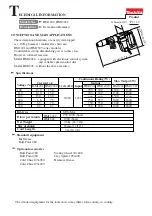
Danger!
Electric Shock
Electric shock, or electrocution, refers to the flow of electric current through the human body.
The degree of electric shock is related to the value of the current that flows through the body, and the path through which
the current flows. While weak currents will produce only a tickling feeling, they could also cause burns, respiratory problems,
cardiac impairment, or in the worst case the loss of life.
For a voltage of 100 V, the resistance of human skin is approximately 5 k
Ω
in dry conditions.
In wet conditions, it drops to about 2 k
Ω
. The resistance of the human body is approximately 300
Ω
.
If you come into contact with 100 V while your skin is wet, about 22 mA of electric current will flow through your body
and you will not be able to break off contact on your own.
This is why performing any operations with wet hands is strictly prohibited.
These numerical values are conceptual. If only a weak current flows either because the capacity of the power supply
is extremely small or the impedance (similar to resistance) of the circuit is large, the danger will be less.
As voltage increases, the air insulation is broken and electricity is discharged, leading to an increased risk of electric
shock even if without direct contact with an electrode. Maintain a safe distance from charged areas, as shown in the
following table.
Care must be taken to avoid approaching these charged areas.
3
15
6
15
10
20
20
30
30
45
60
75
100
115
140
160
270
300
Electric
current value
1 mA
5 mA
10 mA
20 mA
50 mA
100 mA
Effect on human body
Mild tingling
Considerable pain
Unbearable pain
Intense muscular contraction,
unable to break away from circuit on one's own
Considerably dangerous
Fatal consequences
Voltage of
charged area (kV)
Safe distance (cm)
06


























